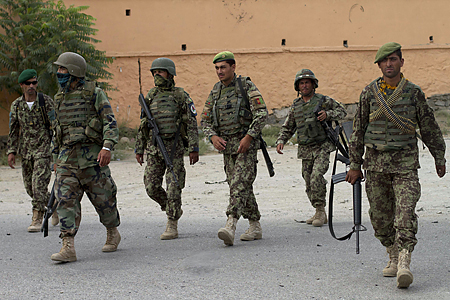
Afghan soldiers walks outside the governor's compound after an attack in Parwan's provincial capital of Charikar, some 30 miles (50 kilometers) north of Kabul, Afghanistan, Sunday, Aug. 14, 2011. (Photo: Dar Yasin / AP)
The military intervention in Afghanistan that began a month after the 9/11 attacks is the longest war in U.S. history, costing 1,750 American lives (and counting) and upward of $300 billion (and counting). And it’s becoming harder to believe Washington’s promises that the end is in sight. President Obama will, this year, withdraw 30,000 of the 100,000 troops currently serving in Afghanistan, drawing to an end the surge he initiated soon after coming into office. And, according to Obama’s script, in 2014 the U.S. will hand over security control of the country to the Afghan National Army, currently being built at a cost of almost $12 billion a year — allowing the U.S. to leave behind a residual force of less than 20,000 troops.
All well and good in theory, as long as the Afghan National Army hasn’t entirely disappeared by then. The Washington Post reported on Sunday that NATO figures show that the first six months of 2011 saw 24,000 ANA soldiers simply walk off the job. That’s one in seven soldiers of the force’s 170,000 troops, an alarming rate of desertion that at one point in the summer reached an annualized rate of 35%. And Barbara Slavin at IPS was told by Brig. Gen. Guy “Tom” Cosentino, deputy commanding general for regional support at the NATO Training Mission-Afghanistan, that last year’s attrition rate was 32 percent, and is currently on track to reach a figure of 24% for 2011 — i.e. one in four soldiers.
The idea that the Afghan security forces will take over the fight against the Taliban when the U.S.-led foreign contingent leaves has always seemed a little fanciful, given their track record in the field until now and the very limited support enjoyed by the Karzai government they would be defending. But if one in four Afghan soldiers is cutting and running thee years before the U.S. is scheduled to depart — well, let’s just say President Obama’s Afghanistan strategy is based on assumptions that are, to put it mildly, decidedly optimistic.
Of course, the unspoken but obvious component of the U.S. strategy involves a political settlement: The prospect of the shaky Afghan security forces succeeding where NATO has failed until now in suppressing the Taliban is obviously fanciful. The surge strategy was couched as a plan to inflict sufficient pain on the Taliban in the field to make the insurgents more amenable to the terms of the U.S. and its allies for a negotiated solution. But even that strategy requires making the Taliban feel as if they’re losing the war. Right now, despite U.S. forces killing hundreds of Taliban local and mid-level commanders and senior U.S. officers insisting that the insurgency is suffering , the Taliban doesn’t seem to agree. Indeed, the insurgency would claim to have had a very good summer. August was the deadliest month for U.S. forces in Afghanistan since the war began, with 66 killed. And despite frequent U.S. military claims about stopping the Taliban’s momentum, violence in Afghanistan actually increased by more than 50% during the second year of President Obama’s troop surge.
The Taliban may, indeed, be signaling an increased willingness to talk, but strictly on their own terms. Well aware of the growing strain on the U.S. and other cash-strapped NATO countries of maintaining an open-ended commitment to an expeditionary war, it’s not hard to see why the Taliban may believe that time, and momentum, is on their side.
Taliban leader Mullah Omar, in his Eid message that closed out the Ramadan fast last month, expressed pleasure at the setbacks his forces had inflicted on the Americans, but at the same time signaled an intent to talk. Indeed, he made clear that talks between the Taliban and the U.S. are already under way, although he stressed those were focused on prisoner exchanges rather than a political settlement to the conflict. Still, longtime Taliban watcher Ahmed Rashid sees Mullah Omar preparing his own side for a political settlement.”The talks have dealt with prisoner releases as part of confidence building measures to create the right atmosphere for a wider and more sustained political dialogue,” Rashid writes, adding that “By acknowledging that there have been contacts with the Americans, Mullah Omar is sending a clear message to his fighters that future political talks are a possibility, while signaling to the Americans that he may eventually be prepared to broaden the scope of the dialogue and those already participating in it.”
But whereas the official U.S. position has always been that the Taliban must accept the Afghan constitution drawn up in the wake of the invasion and integrate itself into the post-invasion political process, Mullah Omar talks of a “real Islamic regime which is acceptable to all people of the country” and in which “all ethnicities will have participation in the regime”. Also he promises that the Taliban won’t seek to monopolize power as it did after its 1996 takeover. In other words, the Taliban expects to set the terms for a political solution rather than accept those demanded by the United States and its allies.
The question of which side will have to accept more of the other’s terms will be determined by the balance of power on the ground. But Taliban leaders are clearly imagining that time, momentum and the limits of their adversary’s commitment to the war are working in their favor. Those who hope to see U.S. and NATO forces going home in large numbers by 2014, then, had best hope they can persuade some of those tens of thousands of Afghan National Army deserters to return to their posts.

